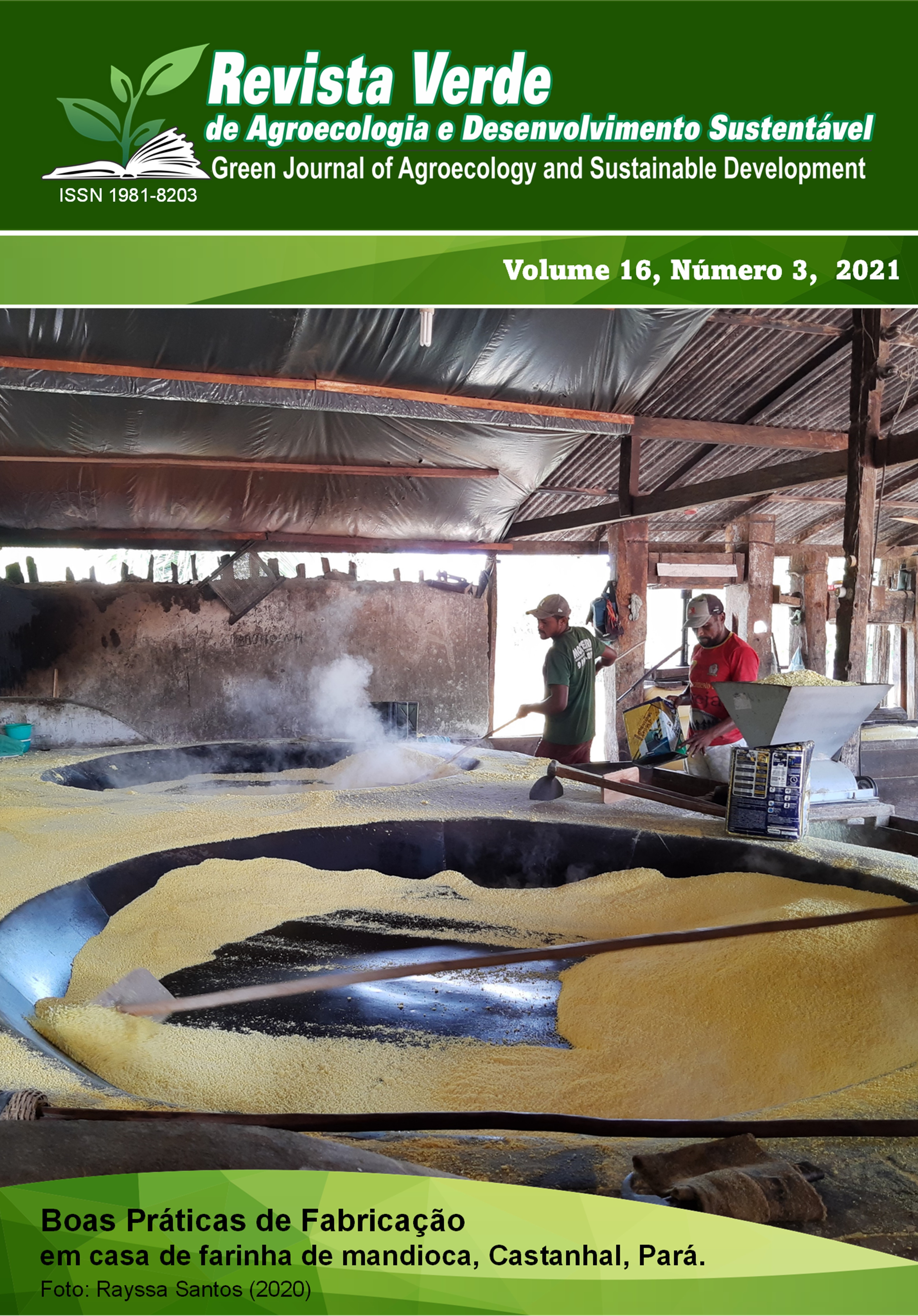Azolla production as a protein source to poultry: a case study in family poultry farmers in Rio Grande do Sul, Brazil
DOI:
https://doi.org/10.18378/rvads.v16i3.8314Keywords:
Alternative animal feeding, Family poultry farming, Agroecological practiceAbstract
The present article addresses the activities involved in the construction of two tanks for the production of Azolla (Azolla sp.), an aquatic fern that can be used as poultry feed. The activities took place in Capão do Leão and São Lourenço do Sul, in the southern part of Rio Grande do Sul state. Two models of tanks were built, the one in Capão do Leão being outside the paddocks and the one in São Lourenço do Sul being inside one of the paddocks accessed by poultry. We observed a rapid Azolla propagation, with tanks being fully occupied by the plant in about 14 days of cultivation. Shading was fundamental for the good development of Azolla and to keep its characteristic green color. Lack of shade altered Azolla’s color and increased other vegetal species development. There was an excellent acceptance of Azolla by chickens. The supply of Azolla inside the paddocks resulted in overconsumption, promoting a drastic decrease in its population, which took an increased amount of time to be reestablished and had to compete with other species. It was easier to maintain Azolla population when the tank was built outside the paddock, although, in such case, there was a greater necessity of labor. The low cost, rapid propagation and ease of cultivation of Azolla can encourage other poultry breeders to use it as a nutritional source for chicken.
Downloads
References
ALALADE, O. A.; IYAYI, E. A. Chemical composition and the feeding value of Azolla (Azolla pinnata) meal for egg-type chicks. InternationalJournalofPoultry Science, v.5, p.137-141, 2006. https://doi.org/10.3923/ijps.2006.137.141.
ALMEIDA, C.; MASSARANI, L.; MOREIRA, I. C. As percepções de pequenos agricultores brasileiros sobre os cultivos geneticamente modificados. Ambiente & Sociedade, v. 18, n.1, p.203-220, 2015. https://doi.org/10.1590/1809-4422ASOC891V1812015en.
ANITHA, K. C.; RAJESHWARI, Y. B.; PRASANNA, S. B.; SHILPA SHREE J. Nutritive evaluation of Azolla as livestock feed. Journal of Experimental Biology and Agricultural Sciences, v.4, n.6, p.670-674, 2016. https://doi.org/10.18006_2016.4(Issue6).670.674.
ARA, S.; ADIL, S. F.; BANDAY, M. T.; KHAN, M.; ADIL, S. Feeding potential of aquatic fern-Azolla in broiler chicken ration. Journal of Poultry Science and Technology, v.3, p.15-19, 2015.
BROUWER, P.; SCHLUEPMANN, H.; NIEROP, K. G. J.; ELDERSON, J.; BIJL, K. P.; VAN DER MEER, I.; DE VISSER, W.; REICHART, G.; SMEEKENS, S.; VAN DER WERF, A. Growing Azolla to produce sustainable protein feed: the effect of differing species and CO2 concentrations on biomass productivity and chemical composition. Journal of the Science of Food and Agriculture. v.98, p.4759-4768, 2018. https://doi.org/10.1002/jsfa.9016.
CHERRYL, D. M.; PRASAD, R. M. V.; JAGADEESWARARAO, S., JAYALAXMI, P., KUMAR, D. S. A study on the nutritive value of Azolla pinnata. Livestock Research International, v.2, n.1, p.13-15, 2014.
DE ALMEIDA, V. E. S.; FRIEDRICH, K.; TYGEL, A. F.; MELGAREJO, L.; CARNEIRO, F. F. Uso de sementes geneticamente modificadas e agrotóxicos no Brasil: cultivando perigos. Ciência & Saúde Coletiva, v.22, n.10, p.3333-3339, 2017. https://doi.org/10.1590/1413-812320172210.17112017.
GUILHERME, L. C.; SOBREIRA, R. S.; DE OLIVEIRA, V. Q. Sisteminha Embrapa-UFU-FAPEMIG: Sistema Integrado de Produção de Alimentos-Módulo1: tanque de peixes.1.ed. Teresina: EmbrapaMeio-Norte, 2019. 63p.
JOYSOWAL, M.; AZIZ, A.; MONDAL, A.; SINGH, S. M.; BODA, S.; CHIRWATKAR, B.; CHHABA, B. Effect of Azolla (Azolla pinnata) feed on the growth of broiler chicken. Journal of Entomology and Zoology Studies, v.6, n.3, p.391-393, 2018.
KESHAB, B.; DIPANJALI, K.; SANTANU, B.; GIRISH, P. S.; GOKULDAS, P. P.; RAJENDRAN, T.; SWARAJ, R. Effect of supplementation of Azolla (Azolla carolini) meal on performance of crossbred (Hampshire x Ghungroo) pigs. Indian Journal of Animal Nutrition, v.35, n.4, p.469-472, 2018. https://doi.org/10.5958/2231-6744.2018.00071.3.
KHURSHEED, I.; MASUD, S.; KHAN, A.; KHAN, N.; KOUR, S.; DUA, S.; KHURSHEED, I. Proximate evaluation of Azolla pinnata as sustainable feed supplement for poultry. Journal of Pharmacognosy and Phytochemistry, v.8, n.3, p.3157-3160, 2019.
KÖPPEN, W. Climatologia. Buenos Aires: Fundo da cultura econômica, 1931.
KUMARI, J. The effect of different level of Azolla meal on nutrient utilization and growth performance in goa kids.2015. 101f. Tese (Doutorado em Nutrição Animal) - BIHAR Agricultural University, Índia, 2015.
PANDA, H. Biofertilizer for rice ecosystem. In: PANDA, H. (ed.). Manufacture of Biofertilizer and Organic Farming. Nova Déli: Asia Pacific Business Press, 2011. p.63-83.
PARTHASARATHY, R.; KADIRVEL, R.; KATHAPERUMAL, V. Chemical evaluation of Azolla as poultry feed ingredient. Cheiron, v.30, n.1e2, p.35-37, 2001.
PILLAI, K. P.; PREMALATHA, S.; RAJAMONY, S. Azolla - A sustainable feed substitute for Livestock. LEISA INDIA, v.4, p.15-17, 2002.
RANI, M.; JHA, A. K. Potential of Azolla in sustainable agriculture and climate change mitigation. In: BAJPAJ, O.; KHAN, K. (eds.). Recent trends in tropical plant research. Nova Déli:AkiNik Publication, 2019. p.25-37.
ROY, P. S.; ROY, A.; PATHAK, P. K.; MANDAL, N.; SOREN, S.; KUMAL, S. 2015. Effect of Azolla supplementation on milk yield and economics under farmers’ field. Journal of Crop and Weed, v.14, n.2, p.77-80, 2015
SHUKLA, M.; BHATTACHARYYA, A.; SHUKLA, P. K.; ROY, D.; YADAV, B.; SIROHI, R. Effect of Azolla feeding on the growth, feed conversion ratio, blood biochemical attributes and immune competence traits of growing turkeys. Veterinary World, v.11, p.459-463, 2018. https://doi.org/10.14202/vetworld.2018.459-463.
SMALL, E.; DARBYSHIRE, S. J. Blossoming treasures of biodiversity. 35. Mosquito Ferns (Azolla species) – tiny ‘super plants. Biodiversity,v.12, n.2, p.119–128, 2011. https://doi.org/10.1080/14888386.2011.585928.
TALLEY, S. N.; TALLEY, B. J.; REINS, D. W. 1977. Nitrogen fixation by Azolla in rice fields. In: HOLEANDER, A. (ed). Genetic Engineering in Nitrogen Fixation. Nova Iorque: Plenum Press, 1977. p. 255-456.
Downloads
Published
How to Cite
Issue
Section
License
Copyright (c) 2021 Carlo Juliantro Giehl et al.

This work is licensed under a Creative Commons Attribution 4.0 International License.











